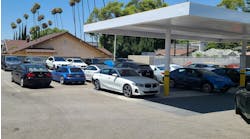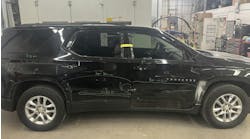The ECM on this vehicle needs to know what the vehicle speed is so that it can manage spark and fuel outputs as well as the cruise control function on this throttle by the wire equipped engine. The ECM also must know if the vehicle is bouncing over a rough road, which would create some rotational variation in the heavy crankshaft assembly. This rough road induced crankshaft rotational variation may fool the CKP sensor into thinking the crankshaft failed to speed up during a firing event due to engine misfire rather than the centrifugal force of the crankshaft.
The way the ECM can sense rough road is by using a wheel speed sensor. As the wheel bounces, the rotation of the sensor varies accordingly. This vehicle has a right front wheel speed sensor even when the vehicle is not outfitted with ABS brakes for these ECM purposes. This wheel speed sensor generated VSS signal is also sent to the scan tool by the ECM for a VSS PID. So you can have a transmission that shifts correctly, a speedometer that works yet and not read any VSS signal on the scanner. Tricky!
Contrast this Saturn VSS setup with that of many Nissan models that use both a VSS sensor mounted on the transmission that feeds the instrument cluster information and yet also has a revolution sensor, also mounted on the transmission, that feeds VSS information to the TCM. Because the ECM, TCM and instrument cluster all share information on the same communication network, you again can have a transmission that shifts properly, a speedometer that works and a scanner that reads a VSS signal yet still set VSS DTCs. Tricky still!
When testing any type of VSS signal, pay careful attention to not only where the sensor for the particular module is located, but also under what setup conditions the sensor is to be tested. Look at the zoomed out view of several VSS sensors from this common Volkswagen set up in Figure 2. You can see the amplitude, or the top signal, increase with vehicle speed then drop to nothing as the rotating member within the transmission stops spinning on the gear change yet the lower signal never drops out as it is sensing another transmission member. Unless you follow the test setup procedures in the service information, you might be fooled into thinking you lost your signal when in fact this dropout is normal.On vehicles with a non-limited slip final drive you must often hold one wheel and spin another in order to get proper signal output under specific conditions.
Being that different modules can handle VSS information, there are sometimes programming requirements in related modules beyond programming just the module you replaced. On many Chrysler vehicles, you must program either the ABS module or the TCM with tire size and final drive gear ratio when installing a new ECM for all signals to work properly.
As always, make sure you read the service information first!
Jim Garrido of "Have Scanner Will Travel" is an on-site mobile diagnostics expert for hire. Jim services independent repair shops in central North Carolina. He also teaches diagnostic classes regionally for CARQUEST Technical Institute.




